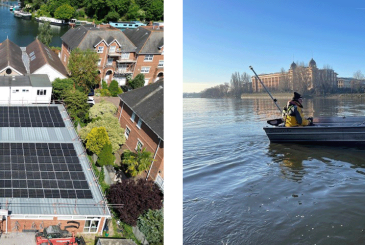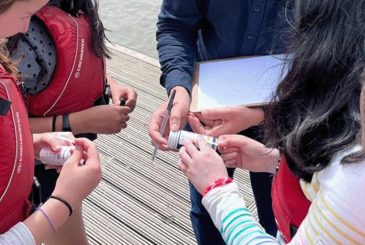Although it’s possible for rowing clubs to operate without a building, almost all have a boathouse. And for the majority of clubs in Britain that have long histories, there comes a time when the ‘old shed’ is no longer fit for purpose. The only way these clubs can keep going, never mind expand their activities, is to invest in a refurbishment, extension or even a full rebuild.
However, hard times and the decline of central government funding mean that clubs need to be agile and creative in developing and funding infrastructure projects. Zoe Gullen talks to several clubs about the imaginative approaches they used to fund their schemes
Planning for success
Drawing up a clear and realistic plan, which is both affordable and can be completed within a reasonable time frame, is essential. British Rowing Facilities Service can help with this as part of its remit to assist clubs in developing facilities; areas where it can assist range from negotiating leases to putting together funding proposals.
‘Once you know what it is you are going to do, that’s when you can start asking for money.’
Mike Hendry, Walton RC
At Walton RC, it had become increasingly evident that their old boathouse was falling down. Mike Hendry, who was part of the core team delivering the new boathouse in 2009-10, says, ‘Things got real when someone sketched up a plan likely to get planning permission and within the bounds of what the club could afford. Once you know what it is you are going to do, that’s when you can start asking for money.’
The club put the design and build out to tender, and while the quotes were very reasonable there was not enough money to cover the full project. As a result, the plans were modified and construction took place in two phases: first the shell and ground floor fit-out, and then the upper floor over the next two years. Although this did mean the overall outlay increased by a small amount, it gave the club greater flexibility.

Confirming the project
Runcorn are currently in the post-planning phase of their boathouse development, and are confirming their plans. Development co-ordinator Sue Sljivic says that the risks of taking on a mortgage became particularly evident during the pandemic, and so there is ‘not much appetite for taking on a big loan’. She adds that the club committee is prepared to reconsider and challenge the plans – ‘Do we need this? Can we afford to manage it?’ – as funds will be required not just for the build but also running costs (including heating and insurance) and maintenance.

Getting the fundraising sequence right
“It’s essential that the club makes the first move and gets together some seed capital,” explains British Rowing’s Facilities Service Co-ordinator, Alan Meegan. “Potential external funding sources want to see that it’s serious about its plans and has worked on its internal fundraising, including donations in kind.”
Club-based fundraisers
Mike says, ‘You always have to rattle tins, and it’s really important to keep doing that.’
The possibilities are almost endless, and can be as modest as a jar for loose change or as a grand as a black-tie ball. Stratford-upon-Avon held a barn dance and ergathon, while Putney Town put on a movie night and Eurovision party as well as an auction of promises for their new balcony fund. Tideway Scullers School, meanwhile, drew down future income by offering members the opportunity to buy ‘life racking’ in the new boatshed.
Runcorn organised a virtual row to Runcorn in Australia, which raised almost £10,000. They also set up a ‘Crowdfunder’, raising a further £10,000 through a mix of pledges, such as baking cakes, and straightforward donations. The Crowdfunder was all or nothing – they had to reach their target – and was, Sue says, ‘a bit more intense. I’m used to working to deadlines, but could I do that again?’
‘It’s amazing what [members] can do, and what they will do, and what they can donate.’
Barry Pearson, Medway Towns RC
‘Buy a brick’ schemes are also popular, and help to meet fundraising targets by setting defined contributions as well as incentivising donors. Goring Gap’s campaign had tiered contributions, with the purchase of gold, silver or bronze bricks, and donors were rewards with a personalised inscription on the fundraising wall in the new boathouse. At Bristol Ariel, the names of supporters will be included in a band of blue bricks running around the building.
Work in kind
Clubs also have a significant resource in the shape of their membership, who may be able to donate their time and skills, either in management or with physical work. At Walton, a member who was a structural engineer took on the building management as part of the core team, while at Putney Town expertise ranges from architects and surveyors to charity fundraisers; Sue Sljivic’s former company have provided technical support for Runcorn as part of their commitment to corporate social responsibility.
Involvement of members helps to promote engagement and ownership of the project. At Medway Towns, club member Barry Pearson says, ‘Pretty well all the membership got really involved and felt part of it.’ As well as monetary donations including interest-free loans, members used their contacts to help reduce expenditure, particularly through the donation of materials: the windows, two fire doors and beams in the coffee bar were all given to the club. The coffee-bar shutters were made by a member, while the chairs came from another rowing club who were refurbishing their own bar. Racking was made from scaffolding that had been condemned following a fire at a builder’s yard, and members laid and painted the flooring.
As Barry says, ‘Almost all clubs have fifty or a hundred members and it’s amazing what they can do, and what they will do, and what they can donate.’
Fighting funds and member loans
Walton started with a fighting fund – though Mike notes ‘it costs more than you think to get to the point where you can start demolition’. He adds, ‘You reach for every little bit of money where you can find it.’ When there was still a shortfall even after grants and local sponsorship had come in, the club ‘passed the hat around’. The core team committed to covering the funding gap, and then other members stepped up, putting up sums of money as long-term loans at low interest rates and the club was able to draw down funds as required.
Putney Town also used ‘soft’ loans from members to help finance the building of a new ramp. Then, when these had been repaid, the club directed the same amount of money each month into a savings account earmarked for the next development project.
Large-scale funding and grants
Runcorn are seeking an ‘anchor funder’ to commit a substantial sum; then it will be easier to see the pathway to getting others involved.
Grant applications are being submitted, and the club is working with the local authority to show how the development will benefit the area. The river is part of the town’s industrial heritage and, Sue says, ‘In the new development we can host community events and open up at the weekends, making the river more accessible to everyone.’
Tideway Scullers School drew down future income by offering members the opportunity to buy ‘life racking’ in the new boatshed.
Many county sports partnerships offer grants, as well as more localised fundraising bodies: Doncaster RC and Trentham BC received grants from the Coalfields Regeneration Trust, part of which was used to develop the landing stage. Also, while central government funding for sports projects has declined, Sue notes that, ‘There’s money for levelling up and Merseyside, where we are, is one of the areas where levelling up is focused. Let’s get the north-west recognised as a centre for excellence in rowing!’
Photo credit: Mike Hendry










